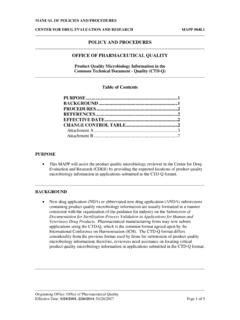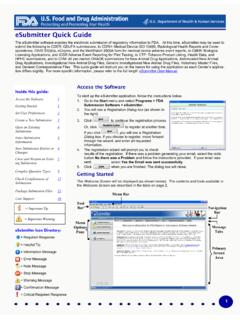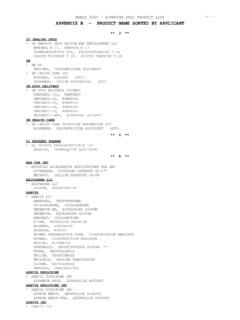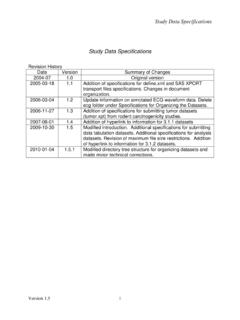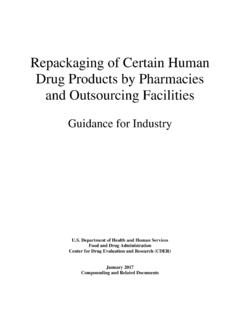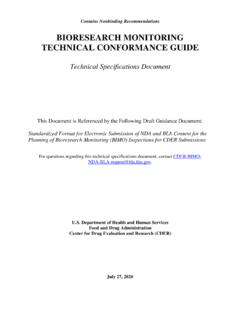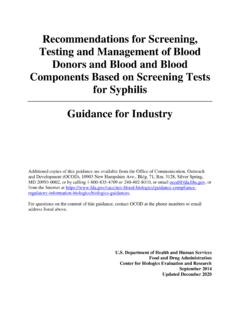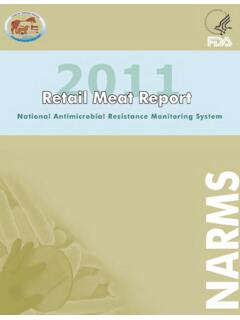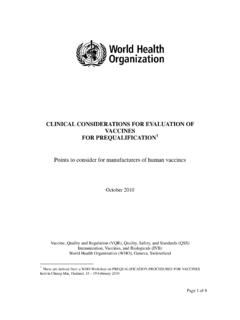Transcription of Human Gene Therapy for Retinal Disorders - Draft Guidance ...
1 Human Gene Therapy for Retinal Disorders Draft Guidance for Industry This Guidance document is for comment purposes only. Submit one set of either electronic or written comments on this Draft Guidance by the date provided in the Federal Register notice announcing the availability of the Draft Guidance . Submit electronic comments to Submit written comments to the Dockets Management Staff (HFA-305), Food and Drug Administration, 5630 Fishers Lane, Rm. 1061, Rockville, MD 20852. You should identify all comments with the docket number listed in the notice of availability that publishes in the Federal Register.
2 Additional copies of this Guidance are available from the Office of Communication, Outreach and Development (OCOD), 10903 New Hampshire Ave., Bldg. 71, Rm. 3128, Silver Spring, MD 20993-0002, or by calling 1-800-835-4709 or 240-402-8010, or email or from the Internet at For questions on the content of this Guidance , contact OCOD at the phone numbers or email address listed above. Department of Health and Human Services Food and Drug Administration Center for Biologics Evaluation and Research July 2018 Contains Nonbinding Recommendations Draft Not for Implementation i Table of Contents I.
3 1 II. considerations FOR PRODUCT 2 III. considerations FOR PRECLINICAL 2 IV. considerations FOR clinical TRIALS .. 4 A. Natural History Studies .. 5 B. Study Design .. 5 C. Study Population .. 6 D. Study Use .. 7 E. Safety considerations .. 7 F. Study Endpoints .. 8 G. Follow-Up Duration .. 9 H. Patient Experience .. 9 V. EXPEDITED PROGRAMS .. 10 VI. COMMUNICATION WITH FDA .. 10 VII. REFERENCES .. 11 Contains Nonbinding Recommendations Draft Not for Implementation 1 Human Gene Therapy for Retinal Disorders 1 2 3 Draft Guidance for Industry 4 5 6 This Draft Guidance , when finalized, will represent the current thinking of the Food and Drug 7 Administration (FDA or Agency) on this topic.
4 It does not establish any rights for any person 8 and is not binding on FDA or the public. You can use an alternative approach if it satisfies the 9 requirements of the applicable statutes and regulations. To discuss an alternative approach, 10 contact the FDA staff responsible for this Guidance as listed on the title page. 11 12 13 I. INTRODUCTION 14 15 This Guidance provides recommendations to stakeholders developing Human gene Therapy (GT) 16 products1 for Retinal Disorders affecting adult and pediatric patients. These Disorders vary in 17 etiology, prevalence, diagnosis, and management, and include genetic as well as age-related 18 diseases.
5 These Disorders manifest with central or peripheral visual impairment and often with 19 progressive visual loss. This Guidance focuses on issues specific to GT products for Retinal 20 Disorders and provides recommendations related to product development, preclinical testing, and 21 clinical trial design for such GT products. 22 23 FDA s Guidance documents, including this Guidance , do not establish legally enforceable 24 responsibilities. Instead, guidances describe FDA s current thinking on a topic and should be 25 viewed only as recommendations, unless specific regulatory or statutory requirements are cited.
6 26 The use of the word should in FDA s guidances means that something is suggested or 27 recommended, but not required. 28 29 30 31 1 Human gene Therapy seeks to modify or manipulate the expression of a gene or to alter the biological properties of living cells for therapeutic use. Human gene Therapy products are defined as all products that mediate their effects by transcription or translation of transferred genetic material or by specifically altering host ( Human ) genetic sequences. Some examples of gene Therapy products include nucleic acids, genetically modified microorganisms ( , viruses, bacteria, fungi), engineered site-specific nucleases used for Human genome editing, ( ) and ex vivo genetically modified Human cells.
7 Gene Therapy products meet the definition of biological product in section 351(i) of the Public Health Service (PHS) Act (42 262(i)) when such products are applicable to the prevention, treatment, or cure of a disease or condition of Human beings. Contains Nonbinding Recommendations Draft Not for Implementation 2 II. considerations FOR PRODUCT DEVELOPMENT 32 33 There are multiple GT products being studied in clinical trials in the United States for Retinal 34 Disorders . GT products are commonly delivered by intravitreal or subretinal injections through a 35 medical delivery system.
8 In some cases, the GT products are encapsulated in a device to be 36 implanted intravitreally. 37 38 The general chemistry, manufacturing and control (CMC) considerations for product 39 manufacturing, testing and release of GT products for Retinal Disorders are the same as those 40 described for other GT products (Ref. 2). For early-phase clinical trials, a sponsor should be 41 able to evaluate the identity, purity, quality, dose, and safety of a GT product. A potency assay 42 to assess the biological activity of the final product, with relevant lot release specifications, 43 should be established prior to the initiation of clinical trials intended to provide substantial 44 evidence of effectiveness for a marketing application.
9 To support licensure of a GT product, 45 manufacturing processes and all testing methods for product release must be validated 46 (21 CFR (e)). Sponsors developing GT products for Retinal Disorders are strongly 47 encouraged to contact the Office of Tissues and Advanced Therapies in the Center for Biologics 48 Evaluation and Research (CBER) early in product development to discuss product-specific 49 issues. 50 51 Sponsors of GT products for Retinal Disorders should take into account general CMC 52 considerations for all GT products (Ref. 2), as well as CMC considerations specific to the 53 products intended for treatment of Retinal Disorders , including: 54 55 Consideration of the final product formulation and concentration to meet the expected 56 dose and volume requirement; 57 58 The endotoxin limit for intraocular delivery is not more than (NMT) Endotoxin Unit 59 (EU)/dose/eye or NMT EU/mL ( USP <771>); 60 61 GT vector-based final products should be tested for particulate matter, and the test 62 method and release criteria should follow USP <789>.
10 63 64 Product testing and release should include testing of the final product configuration; 65 66 Compatibility of the GT product and the delivery system should be evaluated. 67 68 69 III. considerations FOR PRECLINICAL STUDIES 70 71 A preclinical program that is tailored to the investigational product and the planned early-phase 72 clinical trials helps characterize the product s benefit/risk profile for the intended patient 73 population. Overall objectives of the preclinical program for a GT product include: 1) 74 identification of a biologically active dose level range; 2) recommendations for an initial clinical 75 dose level, dose-escalation schedule, and dosing regimen; 3) establishment of feasibility and 76 Contains Nonbinding Recommendations Draft Not for Implementation 3 reasonable safety of the proposed clinical route of administration (ROA); 4) support of patient 77 eligibility criteria; and, 5) identification of potential toxicities and physiologic parameters that 78 help guide clinical monitoring.
